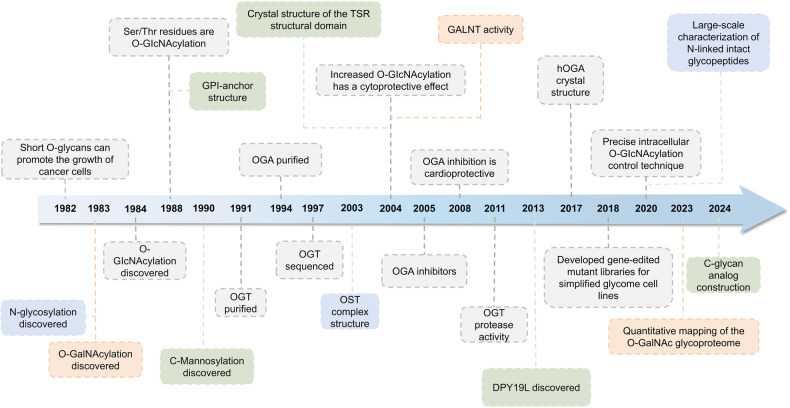Fig. 1.
Timeline of the four major glycosylations development and further investigation. In the early 1980s, there was a preliminary understanding of glycosylation. As the research progressed, the corresponding initiating enzymes and chemical structures were gradually deciphered and recognized. For N-glycosylation, the determination of the Asn-X-Thr/Ser consensus sequence and the structure of the OST complex subunit and some accessory subunits around 2000 led to the in-depth study. Years later, N-linked intact glycopeptides in human serum were identified on a large scale using HILIC enrichment and spectral library searches, and the relationship between N-glycosylation levels and glucose metabolic stress, iron apoptosis, and so on were found. O-glycosylation is mainly classified into two types: O-GlcNAcylation and O-GalNAcylation. Since the 2010s, the close connection between O-glycosylation and physiological processes such as inflammatory response, immune escape, viral infection, cell adhesion, metastasis, apoptosis, etc. has been continuously discovered. Technological breakthroughs around 2020 have also led to the emergence of quantitative determination of maps of the O-glycosylated proteome and the development of gene editing libraries. The understanding of C-glycosylation began in the 1990s with the ongoing discovery of the structure of tryptophan residues in human Rnase linking mannose via C-C bonds. By the 2000s it was understood that C-glycosylation may be a necessary step for ER export in mucin biosynthesis. Recently it has been possible to construct C-glycosylation-modified glycopeptide drugs or glycan analogs in vitro, which greatly improve biological functions. GPI-anchoring has been well understood since the complete structural elucidation in 1988 and the discovery of the initiator enzyme, Transamidase, in 1992. In 2023, the phenomenon and molecular mechanism of feedback regulation of cellular maintenance of GPI-anchored proteins were first elucidated. DPY19L, dpy-19 like C-Man transferase; Gal, d-galactose; GalNAc, N-acetyl-d-galactosamine; GALNT, polypeptide GalNAc transferase; Glc, d-glucose; GlcNAc, N-acetyl-d-glucosamine; GPI, glycosylphosphatidylinositol; HILIC, hydrophilic interaction liquid chromatography; OGA, O-GlcNAcase; OGT, O-GlcNAc transferase; OST, oligosaccharyltransferase; TSR, thrombospondin type 1 repeat

